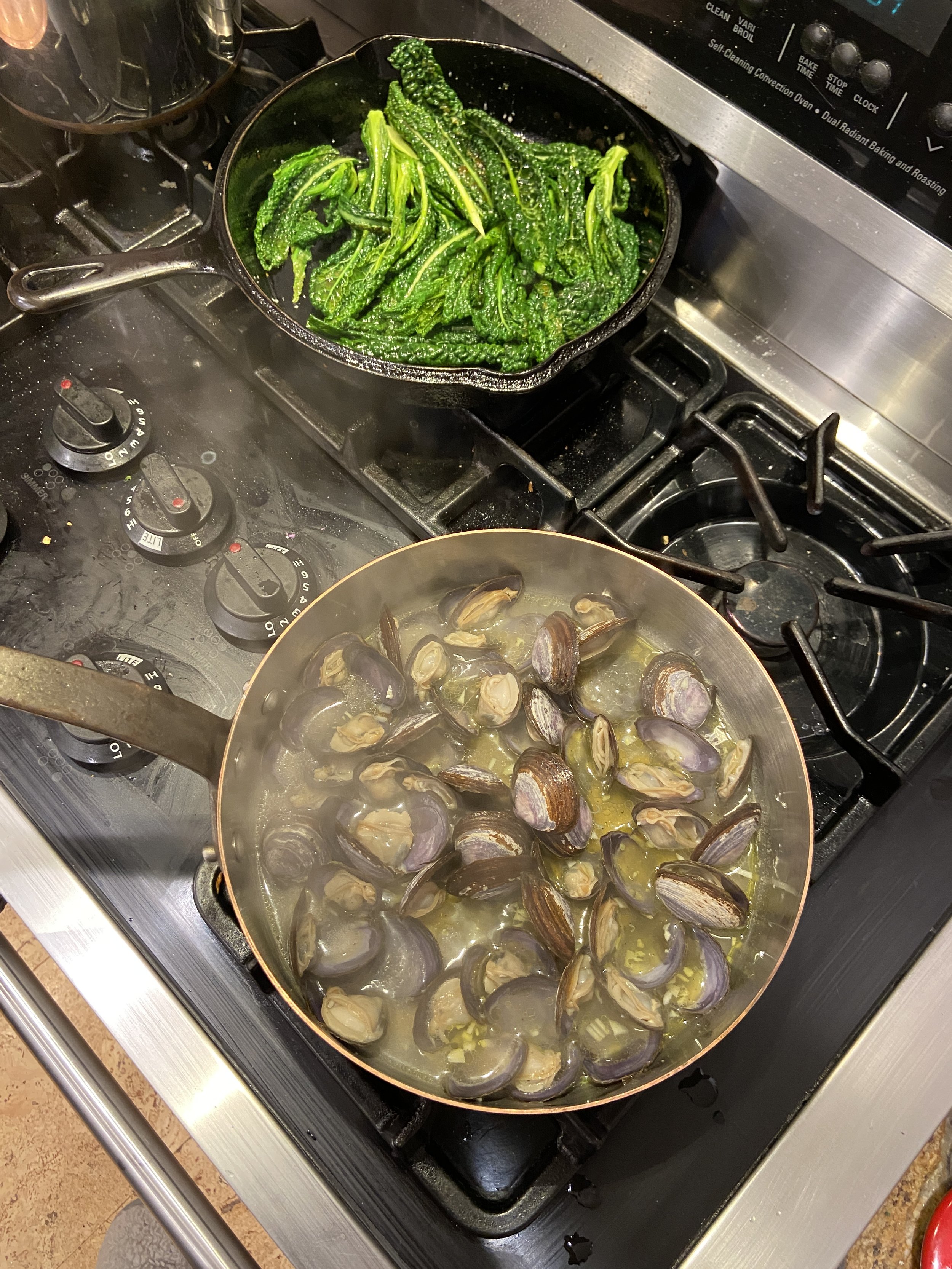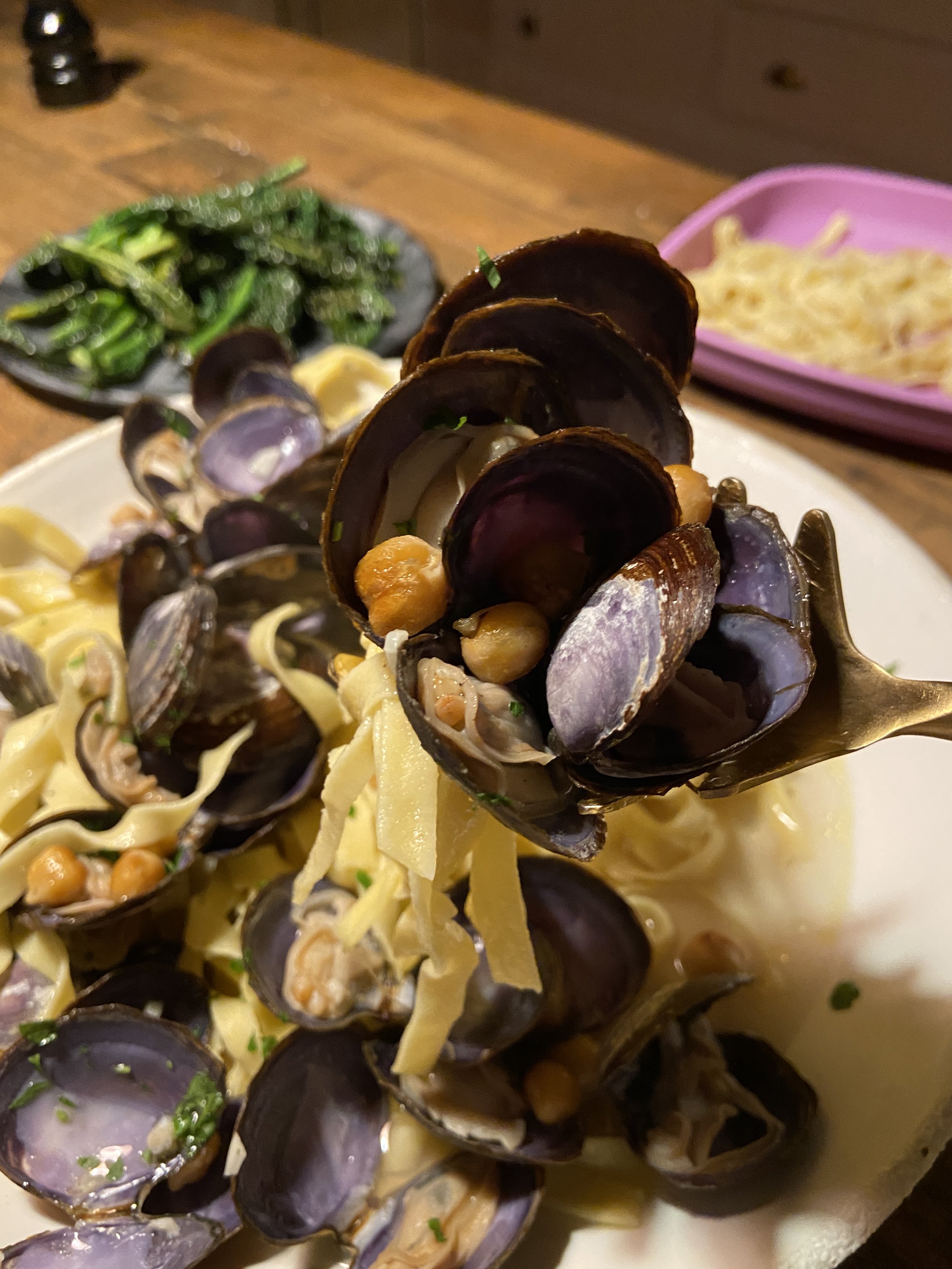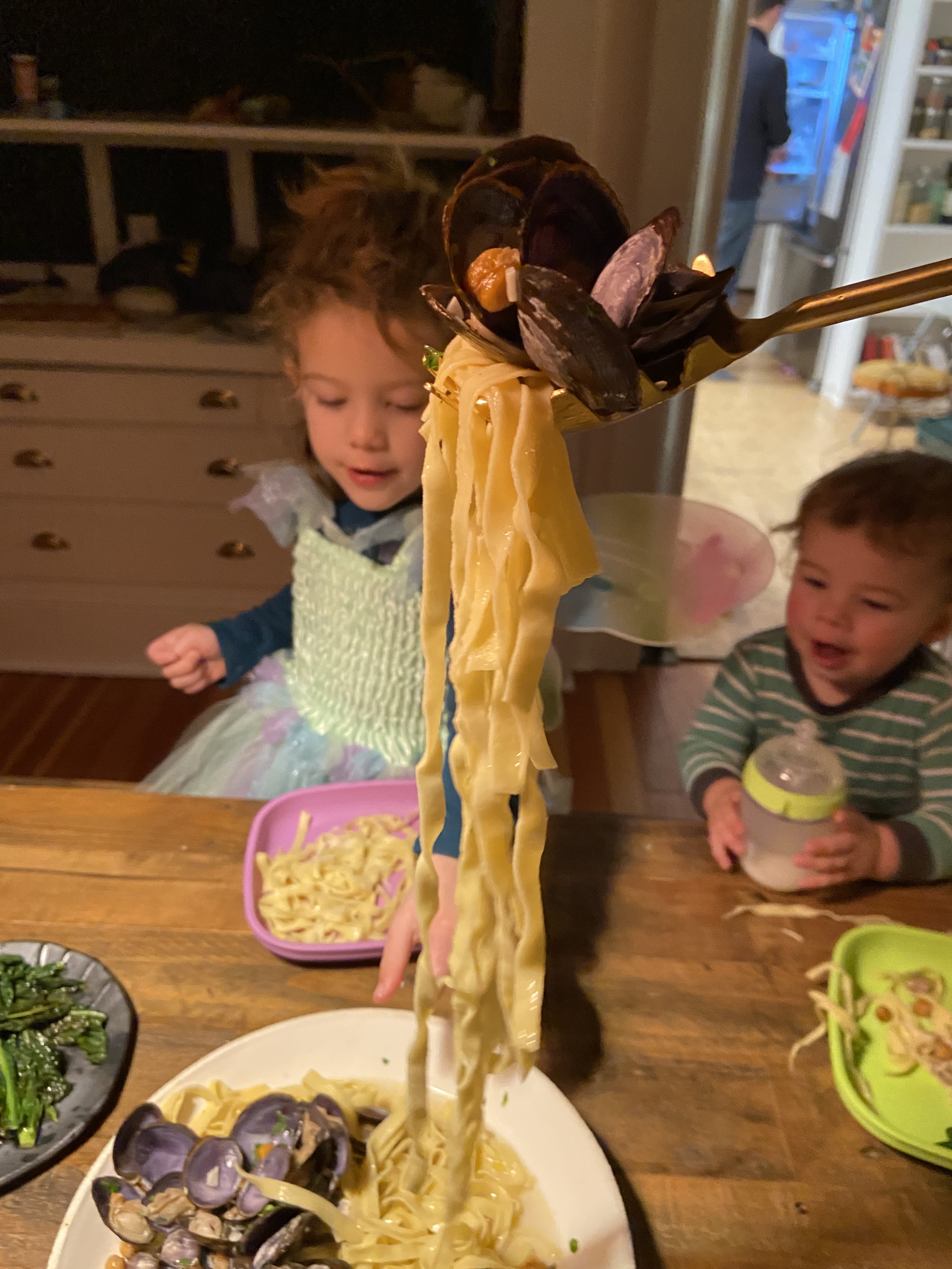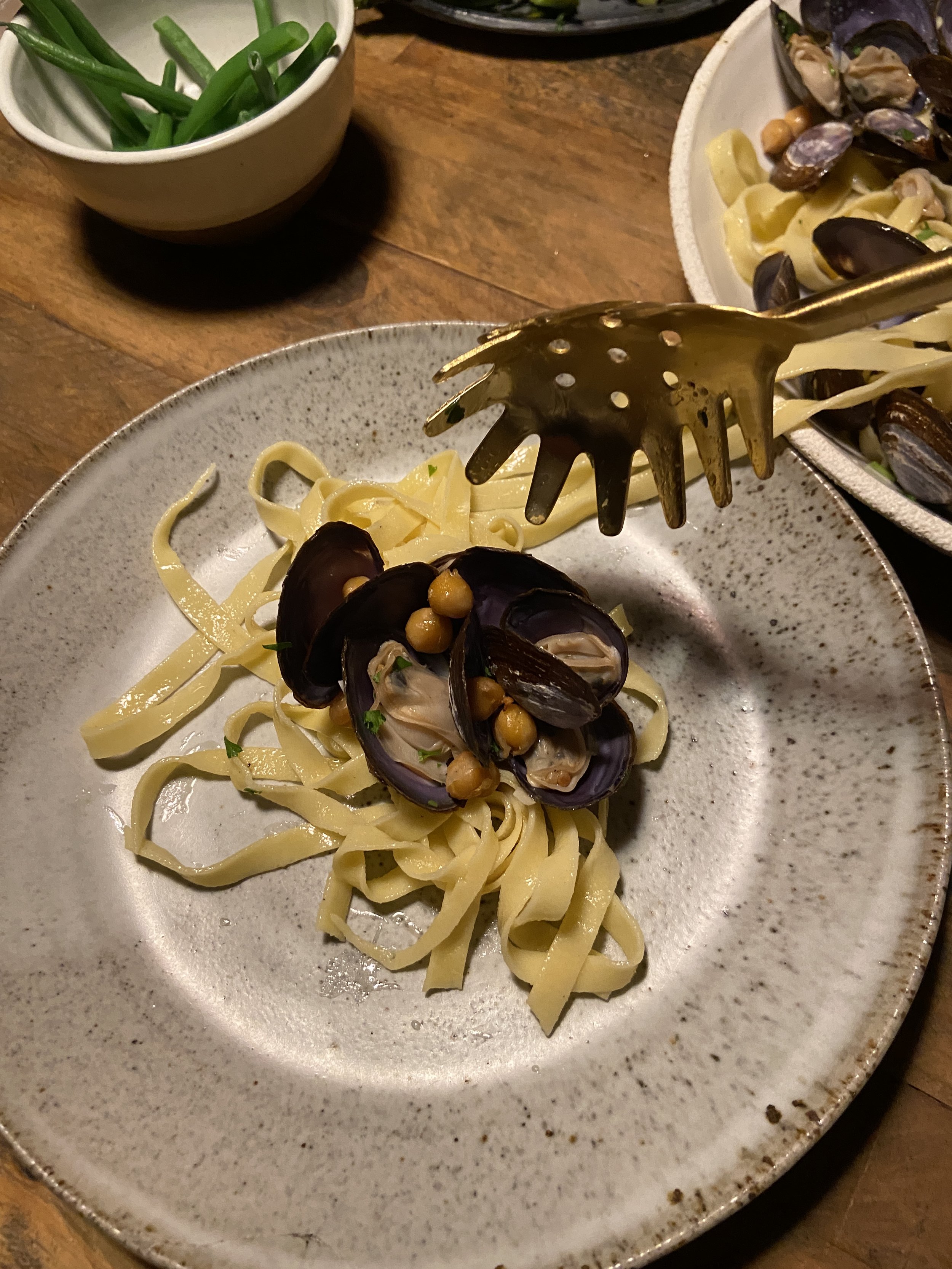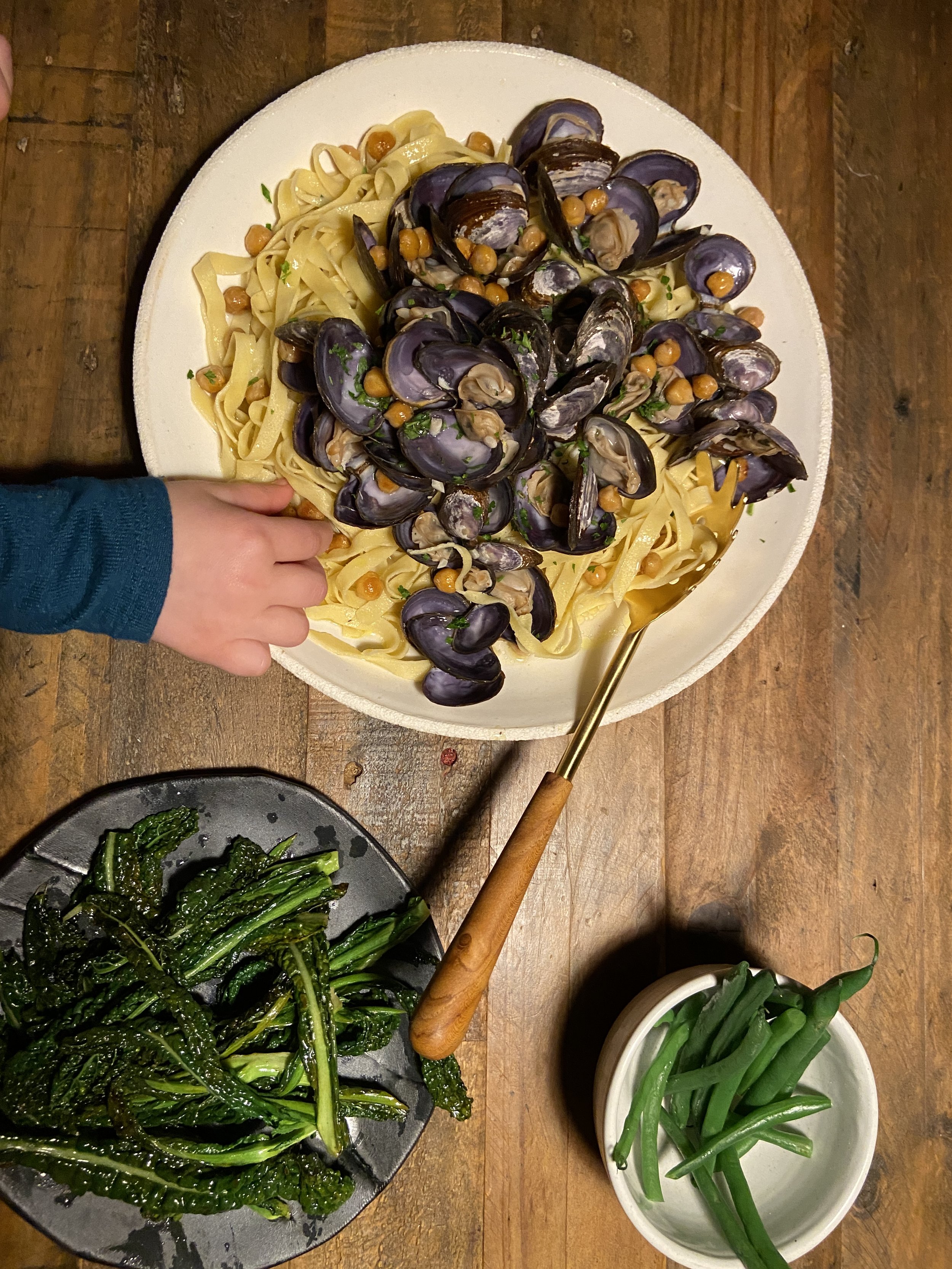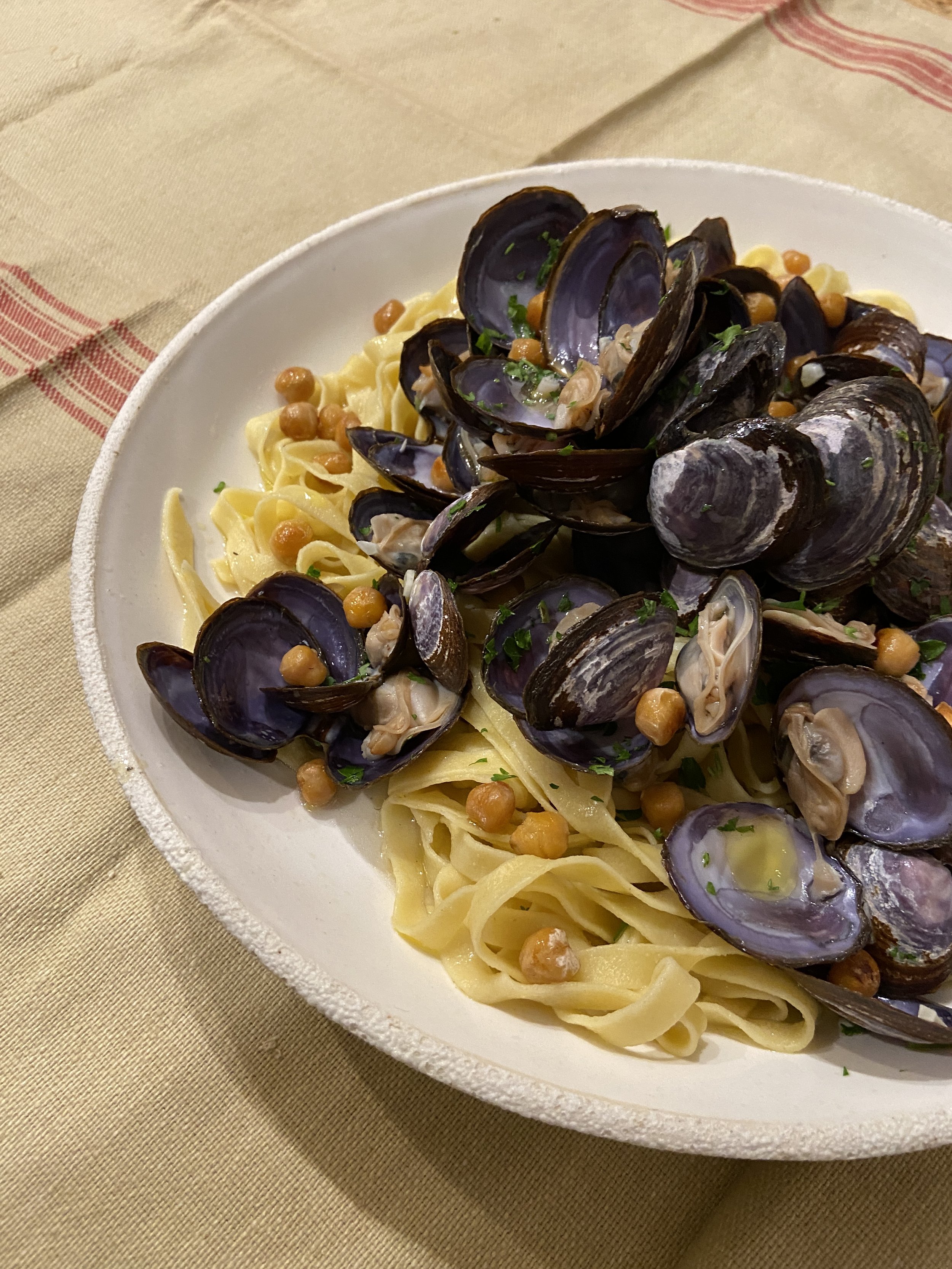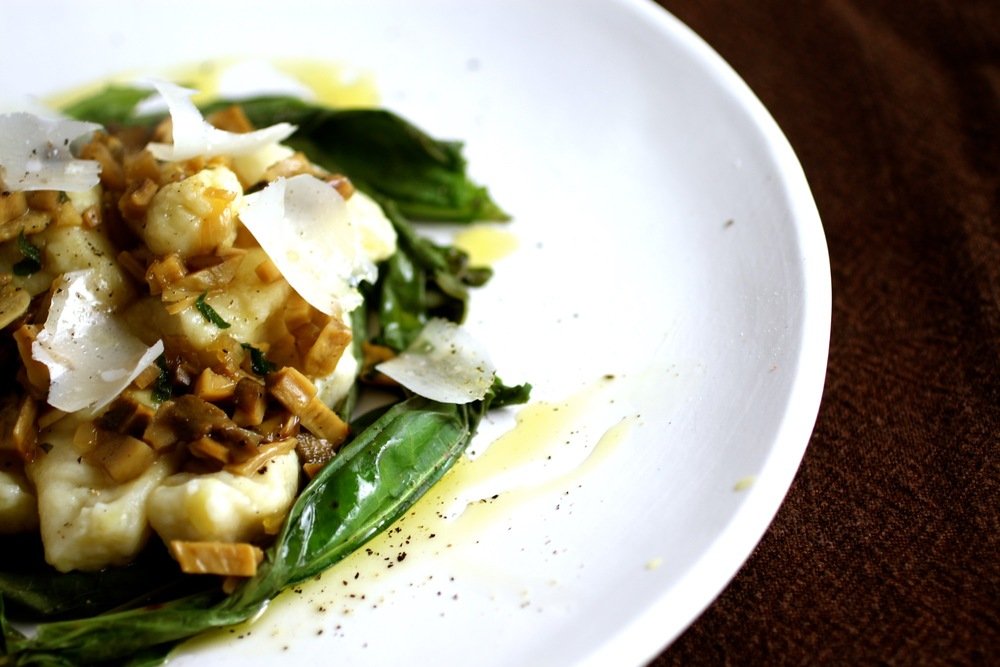Linguini, Chickpeas, & Clams
Clams and bivalves in general can be intimidating but - spoiler alert - they’re actually very easy to cook! Don’t be scared, they won’t bite. Also, compared to other fish and especially to other animal foods, they’re a much more sustainable protein option and, bonus, they’re also a good source of omega-3s. Many are looking to so-called “blue foods” as a key way to improve global health. You can dress them up or down, but I find that simple is usually best (pairing with pasta never hurts) and they’re ready in minutes. Just make sure to buy them from a reputable source and only eat the clams that open when you cook them.
In this recipe, I added a cup of chickpeas that had been sautéed in olive oil/salt. I like adding chickpeas to give the dish more plant-forward fiber and variety, but you can stick with the classic version and leave them out.
Serves 4.
1-2lb fresh clams (we purchased ours from Flying Fish PDX - I believe they’re sustainably farmed)
1 cup cooked chickpeas (optional, see below for cooking recommendation)
1-3 tablespoons olive oil, separated
1 tablespoon butter (can do another tablespoon olive oil, but butter provides great flavor)
1-3 garlic cloves (depending on your love of garlic), chopped
1/2 cup of dry white wine
1-1.5lb fresh pasta, such as linguine (or 8-12oz dried)
Black pepper and sea salt
Fresh parsley, chopped
Freshly grated parmesan (optional)
To Prepare:
Heat a big pot of salted pasta water to a boil. Rinse clams, set aside.
If you’re adding chickpeas, now’s a good time to sauté them in ~1 tablespoon olive oil on medium-high for 5-7 minutes and sprinkle with salt. I like to use the pan that I’m going to cook the clams in then set the chickpeas to the side so I don’t dirty another pan. You can also roast them on a baking sheet - just toss with olive oil/salt and roast on 400 for 20-30 minutes.
In a large sauté pan big enough for all of your clams and some liquid, heat garlic in 1-2 tablespoons olive oil and butter (or just olive oil) on medium until softened, about 3 minutes.
Once garlic has softened, add clams, increase heat to medium-high, add wine, and toss clams until coated and sizzling.
Cook on medium-high until clams pop open. Do not eat any clams that do not open.
Once cook water is boiling, cook pasta (generally, 1 minute for fresh pasta or as directed for dry). DO NOT OVERCOOK because you’ll be adding this pasta to the hot clams before serving.
Once pasta has cooked, drain (save a few tablespoons of pasta water) and toss with olive oil in a large bowl.
Add pasta water to the clams. Serve over pasta and top with coarse ground black pepper, salt, parmesan, and parmesan (if desired).
Gnocchi with porcini and Wilted wild greens
Gnocchi - the pasta of potatoes. If you see gnocchi as simply a vehicle for toppings then you haven't tried legit gnocchi. Making gnocchi from scratch may take time and attention, but the effort is worth it. The resultant soft, pillowy dumplings are stars of the show as much as any sauce. The first time I had the pleasure of tasting homemade gnocchi was in Turin, Italy when I was there for the Slow Food Terra Madre conference and I can still remember the meal - it was that good. My gnocchi may not quite achieve the same level of perfection, but I'll certainly keep trying.
I've made gnocchi several times in the past, each time with a different topping, and I really like how the richness of the mushroom sauce and the green notes of the wild greens (in this case, curly dock - more on the plant in general here) paired with the simple potato pasta in this recipe. The next time I make it however, I will blend the mushroom sauce with an immersion blender for a smoother consistency that doesn't compete with the soft gnocchi "pillows". Feel free to take just the gnocchi portion of this recipe and experiment with your own combinations, such as different mushrooms, a pesto, or a simple marinara sauce. Recipe serves 4.
Gnocchi
Wee little gnocchi dumplings.
2 pounds of golden potatoes
1/4 cup egg, lightly beaten
1 cup all-purpose flour
Sea salt (fine grain)
Fill a large pot with water. Salt the water, then cut potatoes in half and place them in the pot. Bring the water to a boil and cook the potatoes until tender, about 25-30 minutes.
Working one potato at a time, remove potato halves with a slotted spoon and place on a large cutting board. As soon as possible after removing from the water, peel each potato before moving onto the next (these are, obviously, hot potatoes, but you want to work as fast as possible to mash them while they're still hot). Mash potatoes using a fork to create a mound of potato "fluff" - do not over mash. Save the potato water for later.
Let the potato mash cool for about 5 minutes (you want to prevent the egg from cooking). Join the potatoes into a soft mound, drizzle with the beaten egg and sprinkle 3/4 cup of the flour across the top. Using a spatula, scrape underneath and fold to mix in egg and flour. With a very gentle touch, knead the dough. Knead in more flour if dough is too gummy/tacky. The dough should be moist but not sticky.
Lightly flour a new cutting board and separate potato dough into 8 pieces. Gently roll each 1/8th of dough into a log, roughly the thickness of your thumb. Use a knife to cut pieces every 3/4-inch. Dust with a bit more flour.
Shape gnocchi using a fork to create lines in the middle of the gnocchi, so that they kind of look like footballs. Be sure to lightly touch fork into the gnocchi so that it still stays soft and doesn't break. Set gnocchi aside, dusting with flour if needed until you are ready to boil them. Meanwhile, make the porcini sauce.

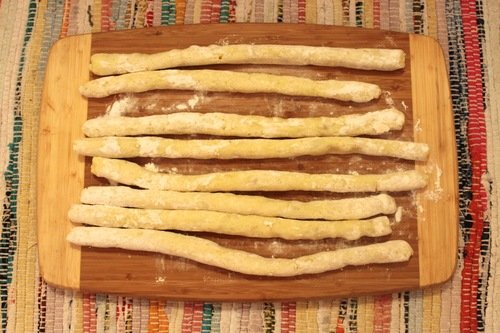
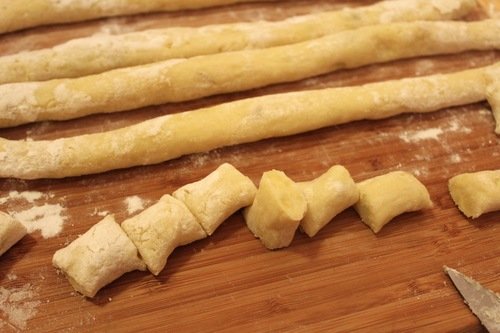
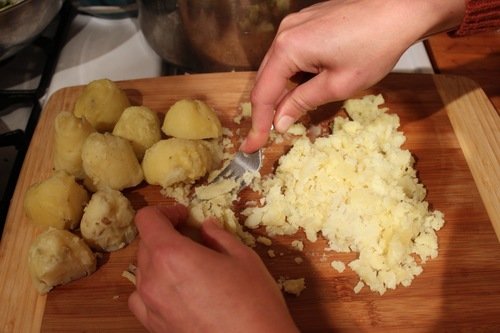
Porcini Sauce
1.5 cups low-sodium chicken broth
0.75 ounces dried porcini mushrooms, rinsed
2 tablespoons extra-virgin olive oil
1 small shallot, minced
1 clove garlic, thinly sliced
1/3 cup dry white wine
2 tablespoons minced fresh parsley
Salt and pepper
Heat broth and porcini in a small saucepan until simmering. Turn off heat, cover, and Let stand until softened, about 5 minutes. Remove mushrooms, reserve liquid, and dice porcini. Heat 1 tablespoon olive oil in a medium skillet over medium heat. Add chopped porcini, shallot, and garlic; cook until lightly browned, 2 to 4 minutes. Stir in reserved liquid, wine, and remaining tablespoon olive oil, scraping up any browned bits. Increase heat to high and bring to boil; cook to reduce, whisking occasionally, about 5 minutes. Stir in parsley and season with salt and pepper to taste. Cover to keep warm.
Cooking and Serving Gnocchi
A few handfuls of foraged dock, dandelion, or other green, thoroughly washed and trimmed
Olive oil drizzle, salt, and pepper, for garnish
Parmesan shavings, for garnish
Reheat the potato water and bring to a boil, adding more water if needed (you need enough water to cover the gnocchi). Cook the gnocchi in small batches by dropping them into the boiling water. Once gnocchi pop up to the top, remove them with slotted spoon ten seconds or so after they've surfaced. Have a large platter ready with dock or other greens that you will be serving with the gnocchi on the plate. Place the gnocchi on the platter on top of the greens - greens will wilt from the heat of the gnocchi. Continue cooking in batches until all the gnocchi are done. Top gnocchi with porcini sauce, a drizzle of olive oil, salt, black pepper, and parmesan shavings.
Chicken & greens Saltimbocca with Brandied Cherries & sage
A unique spin on weeknight chicken.

Brandied cherries are a great complement to the savory chicken and prosciutto.
I have to admit that pounding boneless, skinless chicken breast into a thin sheet and rolling it up with other ingredients isn't something I would have come up with on my own. In fact, I pretty much never buy boneless, skinless chicken breast because it seems like a waste of flavor and texture, but this "transformed saltimbocca" (saltimbocca is traditionally made with veal and prosciutto, rather than chicken and prosciutto) is a great way to rethink chicken dinner and the ingredient combinations are endless. In this version, I used house brandied cherries (so fun to incorporate them into something savory!), spinach, and sage, but other possibilities that have come to mind include: Mashed butternut squash + black olive, gruyere + thyme, parsley + coriander + lemon zest, or even tatsoi + sesame + miso - as you can see, really endless possibilities! A little bit of sweet is nice in any combination, as it pairs nicely with the savory qualities of the chicken and prosciutto. Although the preparation may seem complicated, once you get the hang of it, it's really simple and the actually cooking time is very quick. Below recipe makes 2 generous portions or 4 smaller portions.
2 boneless, skinless chicken breasts (about 1 pound)
Salt and freshly ground black pepper
4-8 thin slices of prosciutto (depending on size, see below)
About 20 fresh sage leaves, divided
1.5 cups fresh spinach
1 tablespoon olive oil, plus more for drizzling
3/4 cup chicken broth
1/4 cup dry white wine
3 tablespoons brandied cherry juice
4-8 brandied cherries (2 per serving)

Chicken cutlets layered with prosciutto, sage, and spinach before rolling up.

A meal of chicken brandied cherry saltimbocca, broccolini, and of course, wine.
Cut chicken breasts in half lengthwise to create 4 pieces and pound using a meat pounder or rolling pin to evenly flatten - pieces should be about 1/4-inch thick. If using a rolling pin, cover chicken with plastic wrap before rolling to prevent cross-contamination.
Sprinkle chicken with salt and ground pepper and lay one slice of prosciutto on each piece of chicken (use more than one piece of prosciutto to cover chicken if needed) followed by 3 leaves of sage per chicken cutlet. Reserve remaining sage leaves.
Heat a skillet on medium-high heat and briefly toss spinach with a drizzle of olive oil and a sprinkle of water. Cook just to wilt, remove from heat, season with salt and pepper, and chop. Arrange spinach in an even layer over the prosciutto slices.
Beginning at the tapered end, roll up each chicken cutlet like you’re rolling up a cinnamon roll. Secure with a toothpick.
Chop 4 of the remaining sage leaves. Heat the tablespoon of oil in a dutch oven or deep skillet on high heat. Cook the chopped sage and chicken rolls until golden brown, about 2 minutes per side. Add the chicken broth and wine and scrape browned bits off bottom of pan with a wooden spoon. Bring liquid to a boil then reduce heat to medium, cover, and simmer until chicken is cooked through, about 8-10 minutes.
Transfer chicken to a platter and remove toothpicks. Continue simmering cooking liquid with 3 tablespoon brandied cherry juice over high heat until it is reduced to about 1/3 cup, or 5-7 minutes then toss in brandied cherries. Drizzle the reduced cooking liquid over the chicken. Serve on top of polenta or other starch with sage leaves and brandied cherries as garnish.

Polenta pairs well with saltimbocca because its soft, simple nature.
Herbed Spaghetti Carbonara
Rich simplicity at its finest bolsted with aromatics.

I've thought about making spaghetti carbonara several times, ever since I was introduced to it in a Ruth Reichl book, but I never did until faced with a nearly empty refrigerator (that fortunately did happen to have very good quality bacon). The rustic simplicity of the dish was always intriguing, but the shear absence of vegetables and color in a main course turned me off. I have to say that when I did finally make I was not disappointed - by tossing in fresh aromatic herbs a pleasant brightness was achieved that balanced the bacon, egg, and garlic.
The coolest thing about spaghetti carbonara is the fact that you cook the egg by tossing them with the freshly cooked pasta. Egg proteins are very sensitive and even just that small amount of heat is enough to denature and partially coagulate them - in other words, the raw egg starts to thicken as the proteins unwind and join back up. This creates a lovely silkiness akin to a fancy sauce only using egg. This is a great recipe to have in your arsenal for when you don't have time and aim to please. Below recipe serves 2-3 and is adapted from Ruth Reichl's recipe.
“As the ingredients are minimal, fresh pasta is really the way to go if you can, but it is not necessary. ”
1 pound of spaghetti or angel hair pasta, preferably fresh
1/4 pound thickly sliced good quality bacon, about 3 thick strips (I got mine from The Local Butcher Shop in North Berkeley and it made a huge difference)
2 cloves garlic, peeled and halved
2 large eggs
1/8 teaspoon (or a few grindings of) black pepper
1-2 handfuls of plucked fresh herbs such as oregano, thyme, and marjoram
Grated parmesan cheese, to top pasta
Bring a large pot of water to a boil for the pasta. If making fresh pasta, complete the below steps before cooking the pasta and if using dried pasta, complete the below steps while the pasta is cooking.

Cut the bacon into thick pieces, about 1/2-inch wide. Cook on medium-high in a skilled until fat begins to render, about 2 minutes. Add the garlic and cook another 5 minutes, until edges of bacon become crisp.
Break the eggs into the bowl you are going to serve the pasta in. Add black pepper and beat with a fork.
Once pasta is cooked (1-2 minutes for fresh, 8-10 minutes for dried), drain and mix with the eggs. Add the bacon and garlic mixture with about one-half of its fat (or more if preferred) along with the fresh herbs and toss into pasta. Serve with grated parmesan and more black pepper if desired.
Pasta Pomodoro with Tuna and Capers
Warm up quickly with spicy tomato and tuna pasta.
“If you want to use fresh pasta in this recipe, simply switch the order of preparation to make the sauce first and cook the pasta while the sauce is simmering, as fresh pasta takes only 1-2 minutes to cook. ”
I'm not glutenphobic or a carb-hater by any means, but my go-to meals at home in my adult life have rarely been pasta. Bulgur, barley, buckwheat? Definitely, but pasta? Infrequent, if ever. This routine changed when my pasta maker-wielding partner moved in. Making pasta from scratch transforms it from a vehicle for sauce and other ingredients to a culinary star that shines all on its own. It has also allowed for experimentation with combinations of flours, such as spelt and semolina.
The inspiration for this recipe came from a dinner at Boot and Shoe Service, with adaptations including whole wheat spaghetti in place of classic, more tuna in the sauce, and red pepper flakes. The great thing about this pasta is it can be made almost entirely from ingredients you probably already have in your kitchen right now (or you can purchase at any time because they do not go bad) and it's incredibly quick, as a pasta meal should be. Serves 2.
“For homemade pasta, use a 1:1 combination of spelt or whole wheat and semolina flours. ”
4 ounces whole-wheat spaghetti
1 tablespoon plus one teaspoon extra-virgin olive oil
1 clove garlic, minced
1 oil-packed anchovy, chopped (optional)
1 14-ounce can diced tomatoes, drained (reserve water)
1/8 teaspoon crushed red pepper flakes
1 can (5 to 6-ounces) good quality tuna, drained and flaked*
1-2 tablespoons California capers (or 2 teaspoons conventional capers)
1 tablespoon minced fresh parsley
Grated parmesan cheese and black pepper (optional)
Bring a large pot of water to a boil. Cook spaghetti to “al dente” (cooked, but still firm), for 9-11 minutes or according to package instructions. Drain and toss with 1 teaspoon olive oil.
Heat remaining tablespoon of oil in a large skillet over medium. Add garlic and anchovies and cook until garlic is golden, stirring and breaking up anchovy with a wooden spoon, about 2 minutes.
Add tomatoes and crushed red pepper flakes and simmer, stirring occasionally, for 15 minutes. Add reserved water from the tomato can as needed to prevent tomatoes from sticking to the skillet.
Once tomato consistency is sauce-like and thick, stir in tuna and capers and cook for another 2 minutes. Divide sauce evenly over cooked pasta and top with parsley and optional parmesan and black pepper. Serve hot.
*To use oil-packed tuna, drain the tuna and use oil from can in place of olive oil. Also be sure to refer to the Monterey Bay Aquarium Seafood Watch Guide for sustainable canned tuna choices.
Serve with: Roasted cauliflower-kale salad with citrus peel and nutmeg.





